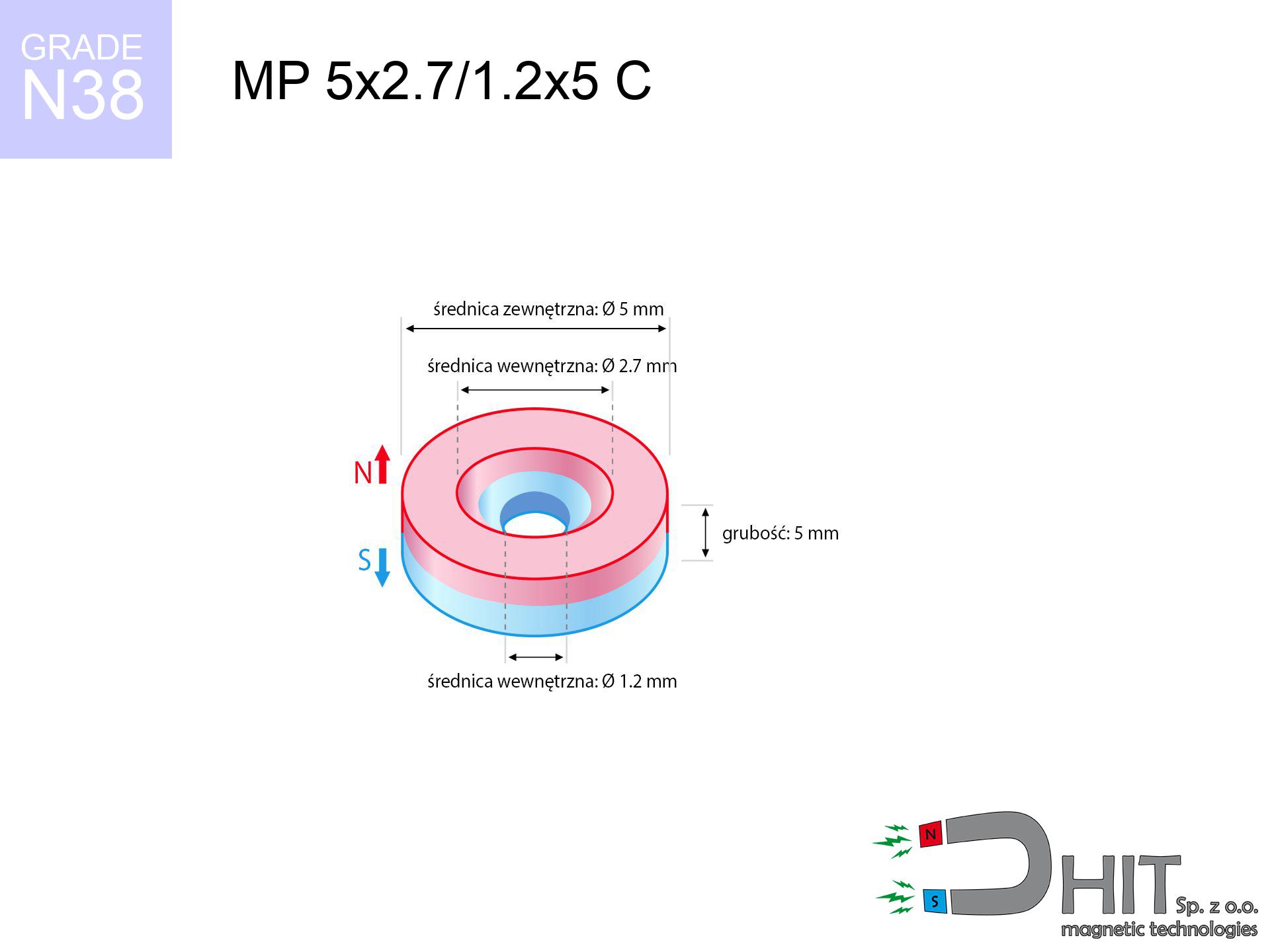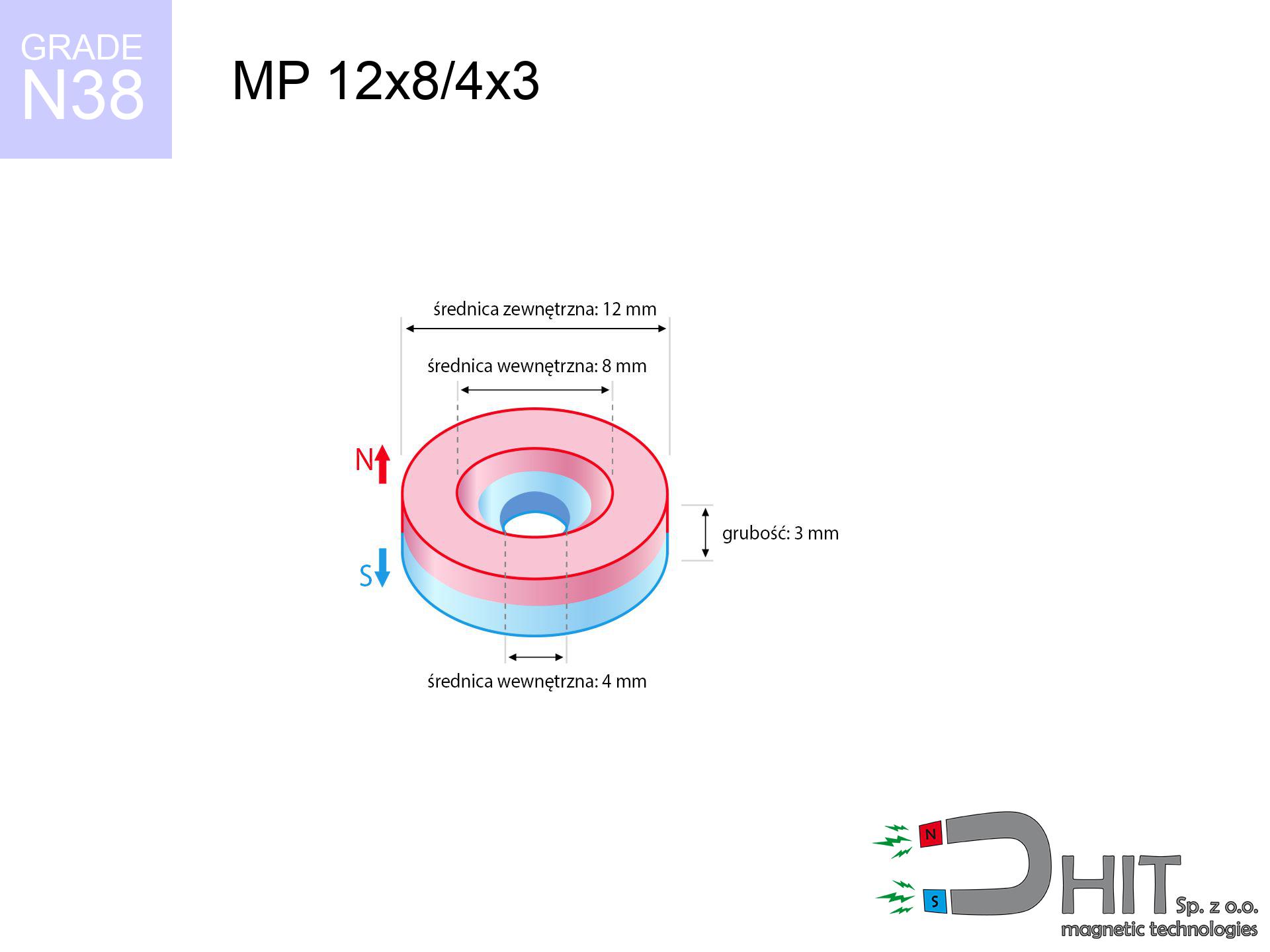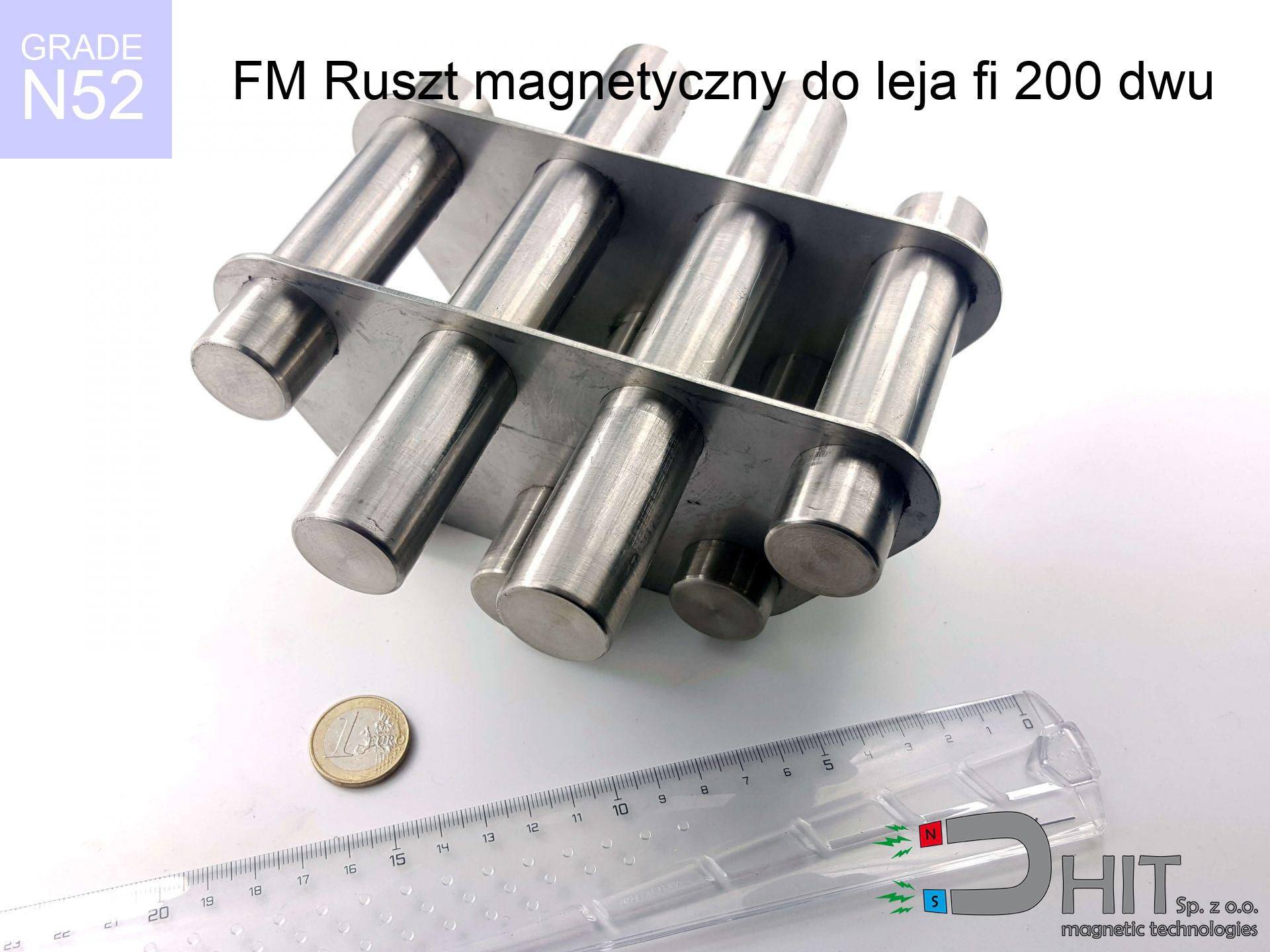MP 5x2.7/1.2x5 C / N38 - ring magnet
ring magnet
Catalog no 030201
GTIN/EAN: 5906301812180
Diameter
5 mm [±0,1 mm]
internal diameter Ø
2.7/1.2 mm [±0,1 mm]
Height
5 mm [±0,1 mm]
Weight
0.69 g
Magnetization Direction
↑ axial
Load capacity
0.75 kg / 7.31 N
Magnetic Induction
553.14 mT / 5531 Gs
Coating
[NiCuNi] Nickel
0.836 ZŁ with VAT / pcs + price for transport
0.680 ZŁ net + 23% VAT / pcs
bulk discounts:
Need more?
Pick up the phone and ask
+48 22 499 98 98
alternatively drop us a message by means of
contact form
the contact section.
Parameters and appearance of a neodymium magnet can be checked with our
force calculator.
Orders placed before 14:00 will be shipped the same business day.
Technical data - MP 5x2.7/1.2x5 C / N38 - ring magnet
Specification / characteristics - MP 5x2.7/1.2x5 C / N38 - ring magnet
| properties | values |
|---|---|
| Cat. no. | 030201 |
| GTIN/EAN | 5906301812180 |
| Production/Distribution | Dhit sp. z o.o. |
| Country of origin | Poland / China / Germany |
| Customs code | 85059029 |
| Diameter | 5 mm [±0,1 mm] |
| internal diameter Ø | 2.7/1.2 mm [±0,1 mm] |
| Height | 5 mm [±0,1 mm] |
| Weight | 0.69 g |
| Magnetization Direction | ↑ axial |
| Load capacity ~ ? | 0.75 kg / 7.31 N |
| Magnetic Induction ~ ? | 553.14 mT / 5531 Gs |
| Coating | [NiCuNi] Nickel |
| Manufacturing Tolerance | ±0.1 mm |
Magnetic properties of material N38
| properties | values | units |
|---|---|---|
| remenance Br [min. - max.] ? | 12.2-12.6 | kGs |
| remenance Br [min. - max.] ? | 1220-1260 | mT |
| coercivity bHc ? | 10.8-11.5 | kOe |
| coercivity bHc ? | 860-915 | kA/m |
| actual internal force iHc | ≥ 12 | kOe |
| actual internal force iHc | ≥ 955 | kA/m |
| energy density [min. - max.] ? | 36-38 | BH max MGOe |
| energy density [min. - max.] ? | 287-303 | BH max KJ/m |
| max. temperature ? | ≤ 80 | °C |
Physical properties of sintered neodymium magnets Nd2Fe14B at 20°C
| properties | values | units |
|---|---|---|
| Vickers hardness | ≥550 | Hv |
| Density | ≥7.4 | g/cm3 |
| Curie Temperature TC | 312 - 380 | °C |
| Curie Temperature TF | 593 - 716 | °F |
| Specific resistance | 150 | μΩ⋅cm |
| Bending strength | 250 | MPa |
| Compressive strength | 1000~1100 | MPa |
| Thermal expansion parallel (∥) to orientation (M) | (3-4) x 10-6 | °C-1 |
| Thermal expansion perpendicular (⊥) to orientation (M) | -(1-3) x 10-6 | °C-1 |
| Young's modulus | 1.7 x 104 | kg/mm² |
Technical analysis of the magnet - technical parameters
These values are the direct effect of a mathematical analysis. Results were calculated on algorithms for the material Nd2Fe14B. Real-world parameters may differ from theoretical values. Please consider these data as a preliminary roadmap during assembly planning.
Table 1: Static force (force vs gap) - power drop
MP 5x2.7/1.2x5 C / N38
| Distance (mm) | Induction (Gauss) / mT | Pull Force (kg) | Risk Status |
|---|---|---|---|
| 0 mm |
5322 Gs
532.2 mT
|
0.75 kg / 750.0 g
7.4 N
|
safe |
| 1 mm |
3295 Gs
329.5 mT
|
0.29 kg / 287.5 g
2.8 N
|
safe |
| 2 mm |
1883 Gs
188.3 mT
|
0.09 kg / 93.9 g
0.9 N
|
safe |
| 3 mm |
1098 Gs
109.8 mT
|
0.03 kg / 31.9 g
0.3 N
|
safe |
| 5 mm |
440 Gs
44.0 mT
|
0.01 kg / 5.1 g
0.1 N
|
safe |
| 10 mm |
92 Gs
9.2 mT
|
0.00 kg / 0.2 g
0.0 N
|
safe |
| 15 mm |
33 Gs
3.3 mT
|
0.00 kg / 0.0 g
0.0 N
|
safe |
| 20 mm |
15 Gs
1.5 mT
|
0.00 kg / 0.0 g
0.0 N
|
safe |
| 30 mm |
5 Gs
0.5 mT
|
0.00 kg / 0.0 g
0.0 N
|
safe |
| 50 mm |
1 Gs
0.1 mT
|
0.00 kg / 0.0 g
0.0 N
|
safe |
Table 2: Slippage force (vertical surface)
MP 5x2.7/1.2x5 C / N38
| Distance (mm) | Friction coefficient | Pull Force (kg) |
|---|---|---|
| 0 mm | Stal (~0.2) |
0.15 kg / 150.0 g
1.5 N
|
| 1 mm | Stal (~0.2) |
0.06 kg / 58.0 g
0.6 N
|
| 2 mm | Stal (~0.2) |
0.02 kg / 18.0 g
0.2 N
|
| 3 mm | Stal (~0.2) |
0.01 kg / 6.0 g
0.1 N
|
| 5 mm | Stal (~0.2) |
0.00 kg / 2.0 g
0.0 N
|
| 10 mm | Stal (~0.2) |
0.00 kg / 0.0 g
0.0 N
|
| 15 mm | Stal (~0.2) |
0.00 kg / 0.0 g
0.0 N
|
| 20 mm | Stal (~0.2) |
0.00 kg / 0.0 g
0.0 N
|
| 30 mm | Stal (~0.2) |
0.00 kg / 0.0 g
0.0 N
|
| 50 mm | Stal (~0.2) |
0.00 kg / 0.0 g
0.0 N
|
Table 3: Wall mounting (sliding) - behavior on slippery surfaces
MP 5x2.7/1.2x5 C / N38
| Surface type | Friction coefficient / % Mocy | Max load (kg) |
|---|---|---|
| Raw steel |
µ = 0.3
30% Nominalnej Siły
|
0.22 kg / 225.0 g
2.2 N
|
| Painted steel (standard) |
µ = 0.2
20% Nominalnej Siły
|
0.15 kg / 150.0 g
1.5 N
|
| Oily/slippery steel |
µ = 0.1
10% Nominalnej Siły
|
0.08 kg / 75.0 g
0.7 N
|
| Magnet with anti-slip rubber |
µ = 0.5
50% Nominalnej Siły
|
0.38 kg / 375.0 g
3.7 N
|
Table 4: Material efficiency (substrate influence) - sheet metal selection
MP 5x2.7/1.2x5 C / N38
| Steel thickness (mm) | % power | Real pull force (kg) |
|---|---|---|
| 0.5 mm |
|
0.08 kg / 75.0 g
0.7 N
|
| 1 mm |
|
0.19 kg / 187.5 g
1.8 N
|
| 2 mm |
|
0.38 kg / 375.0 g
3.7 N
|
| 5 mm |
|
0.75 kg / 750.0 g
7.4 N
|
| 10 mm |
|
0.75 kg / 750.0 g
7.4 N
|
Table 5: Working in heat (material behavior) - resistance threshold
MP 5x2.7/1.2x5 C / N38
| Ambient temp. (°C) | Power loss | Remaining pull | Status |
|---|---|---|---|
| 20 °C | 0.0% |
0.75 kg / 750.0 g
7.4 N
|
OK |
| 40 °C | -2.2% |
0.73 kg / 733.5 g
7.2 N
|
OK |
| 60 °C | -4.4% |
0.72 kg / 717.0 g
7.0 N
|
OK |
| 80 °C | -6.6% |
0.70 kg / 700.5 g
6.9 N
|
|
| 100 °C | -28.8% |
0.53 kg / 534.0 g
5.2 N
|
Table 6: Magnet-Magnet interaction (repulsion) - field range
MP 5x2.7/1.2x5 C / N38
| Gap (mm) | Attraction (kg) (N-S) | Repulsion (kg) (N-N) |
|---|---|---|
| 0 mm |
2.75 kg / 2747 g
26.9 N
5 924 Gs
|
N/A |
| 1 mm |
1.77 kg / 1768 g
17.3 N
8 541 Gs
|
1.59 kg / 1592 g
15.6 N
~0 Gs
|
| 2 mm |
1.05 kg / 1053 g
10.3 N
6 590 Gs
|
0.95 kg / 948 g
9.3 N
~0 Gs
|
| 3 mm |
0.60 kg / 604 g
5.9 N
4 992 Gs
|
0.54 kg / 544 g
5.3 N
~0 Gs
|
| 5 mm |
0.20 kg / 198 g
1.9 N
2 860 Gs
|
0.18 kg / 178 g
1.8 N
~0 Gs
|
| 10 mm |
0.02 kg / 19 g
0.2 N
880 Gs
|
0.02 kg / 17 g
0.2 N
~0 Gs
|
| 20 mm |
0.00 kg / 1 g
0.0 N
184 Gs
|
0.00 kg / 0 g
0.0 N
~0 Gs
|
| 50 mm |
0.00 kg / 0 g
0.0 N
16 Gs
|
0.00 kg / 0 g
0.0 N
~0 Gs
|
Table 7: Hazards (implants) - precautionary measures
MP 5x2.7/1.2x5 C / N38
| Object / Device | Limit (Gauss) / mT | Safe distance |
|---|---|---|
| Pacemaker | 5 Gs (0.5 mT) | 3.0 cm |
| Hearing aid | 10 Gs (1.0 mT) | 2.5 cm |
| Timepiece | 20 Gs (2.0 mT) | 2.0 cm |
| Mobile device | 40 Gs (4.0 mT) | 1.5 cm |
| Car key | 50 Gs (5.0 mT) | 1.5 cm |
| Payment card | 400 Gs (40.0 mT) | 1.0 cm |
| HDD hard drive | 600 Gs (60.0 mT) | 0.5 cm |
Table 8: Impact energy (kinetic energy) - warning
MP 5x2.7/1.2x5 C / N38
| Start from (mm) | Speed (km/h) | Energy (J) | Predicted outcome |
|---|---|---|---|
| 10 mm |
33.26 km/h
(9.24 m/s)
|
0.03 J | |
| 30 mm |
57.59 km/h
(16.00 m/s)
|
0.09 J | |
| 50 mm |
74.35 km/h
(20.65 m/s)
|
0.15 J | |
| 100 mm |
105.14 km/h
(29.21 m/s)
|
0.29 J |
Table 9: Coating parameters (durability)
MP 5x2.7/1.2x5 C / N38
| Technical parameter | Value / Description |
|---|---|
| Coating type | [NiCuNi] Nickel |
| Layer structure | Nickel - Copper - Nickel |
| Layer thickness | 10-20 µm |
| Salt spray test (SST) ? | 24 h |
| Recommended environment | Indoors only (dry) |
Table 10: Electrical data (Pc)
MP 5x2.7/1.2x5 C / N38
| Parameter | Value | SI Unit / Description |
|---|---|---|
| Magnetic Flux | 862 Mx | 8.6 µWb |
| Pc Coefficient | 0.83 | High (Stable) |
Table 11: Underwater work (magnet fishing)
MP 5x2.7/1.2x5 C / N38
| Environment | Effective steel pull | Effect |
|---|---|---|
| Air (land) | 0.75 kg | Standard |
| Water (riverbed) |
0.86 kg
(+0.11 kg Buoyancy gain)
|
+14.5% |
1. Shear force
*Caution: On a vertical surface, the magnet retains only a fraction of its perpendicular strength.
2. Efficiency vs thickness
*Thin metal sheet (e.g. 0.5mm PC case) severely reduces the holding force.
3. Thermal stability
*For N38 grade, the critical limit is 80°C.
4. Demagnetization curve and operating point (B-H)
chart generated for the permeance coefficient Pc (Permeance Coefficient) = 0.83
The chart above illustrates the magnetic characteristics of the material within the second quadrant of the hysteresis loop. The solid red line represents the demagnetization curve (material potential), while the dashed blue line is the load line based on the magnet's geometry. The Pc (Permeance Coefficient), also known as the load line slope, is a dimensionless value that describes the relationship between the magnet's shape and its magnetic stability. The intersection of these two lines (the black dot) is the operating point — it determines the actual magnetic flux density generated by the magnet in this specific configuration. A higher Pc value means the magnet is more 'slender' (tall relative to its area), resulting in a higher operating point and better resistance to irreversible demagnetization caused by external fields or temperature. A value of 0.42 is relatively low (typical for flat magnets), meaning the operating point is closer to the 'knee' of the curve — caution is advised when operating at temperatures near the maximum limit to avoid strength loss.
Chemical composition
| iron (Fe) | 64% – 68% |
| neodymium (Nd) | 29% – 32% |
| boron (B) | 1.1% – 1.2% |
| dysprosium (Dy) | 0.5% – 2.0% |
| coating (Ni-Cu-Ni) | < 0.05% |
Ecology and recycling (GPSR)
| recyclability (EoL) | 100% |
| recycled raw materials | ~10% (pre-cons) |
| carbon footprint | low / zredukowany |
| waste code (EWC) | 16 02 16 |
Other deals
Pros and cons of rare earth magnets.
Pros
- They retain magnetic properties for around ten years – the loss is just ~1% (in theory),
- Neodymium magnets prove to be highly resistant to loss of magnetic properties caused by magnetic disturbances,
- By covering with a reflective layer of silver, the element presents an modern look,
- Neodymium magnets ensure maximum magnetic induction on a contact point, which allows for strong attraction,
- Due to their durability and thermal resistance, neodymium magnets are capable of operate (depending on the shape) even at high temperatures reaching 230°C or more...
- Possibility of precise machining and adapting to complex requirements,
- Key role in electronics industry – they serve a role in HDD drives, electric motors, advanced medical instruments, as well as industrial machines.
- Relatively small size with high pulling force – neodymium magnets offer impressive pulling force in small dimensions, which enables their usage in small systems
Disadvantages
- Susceptibility to cracking is one of their disadvantages. Upon strong impact they can fracture. We advise keeping them in a steel housing, which not only secures them against impacts but also increases their durability
- When exposed to high temperature, neodymium magnets experience a drop in power. Often, when the temperature exceeds 80°C, their strength decreases (depending on the size and shape of the magnet). For those who need magnets for extreme conditions, we offer [AH] versions withstanding up to 230°C
- They oxidize in a humid environment - during use outdoors we advise using waterproof magnets e.g. in rubber, plastic
- Limited possibility of producing nuts in the magnet and complex forms - preferred is casing - magnetic holder.
- Health risk resulting from small fragments of magnets pose a threat, if swallowed, which becomes key in the context of child health protection. Furthermore, tiny parts of these products are able to disrupt the diagnostic process medical when they are in the body.
- High unit price – neodymium magnets have a higher price than other types of magnets (e.g. ferrite), which can limit application in large quantities
Holding force characteristics
Maximum holding power of the magnet – what affects it?
- on a plate made of structural steel, perfectly concentrating the magnetic field
- with a cross-section of at least 10 mm
- with an ground contact surface
- under conditions of ideal adhesion (surface-to-surface)
- during pulling in a direction vertical to the plane
- at ambient temperature room level
Determinants of practical lifting force of a magnet
- Distance (between the magnet and the plate), since even a tiny clearance (e.g. 0.5 mm) leads to a reduction in lifting capacity by up to 50% (this also applies to paint, corrosion or debris).
- Angle of force application – highest force is available only during perpendicular pulling. The shear force of the magnet along the surface is usually several times lower (approx. 1/5 of the lifting capacity).
- Plate thickness – insufficiently thick plate does not close the flux, causing part of the flux to be escaped into the air.
- Plate material – low-carbon steel attracts best. Alloy steels reduce magnetic permeability and lifting capacity.
- Surface structure – the more even the plate, the better the adhesion and higher the lifting capacity. Roughness acts like micro-gaps.
- Thermal environment – temperature increase causes a temporary drop of force. It is worth remembering the thermal limit for a given model.
Lifting capacity testing was performed on a smooth plate of optimal thickness, under a perpendicular pulling force, in contrast under shearing force the lifting capacity is smaller. Additionally, even a slight gap between the magnet and the plate lowers the load capacity.
Precautions when working with neodymium magnets
Nickel allergy
Certain individuals experience a contact allergy to nickel, which is the common plating for NdFeB magnets. Extended handling can result in an allergic reaction. We suggest wear protective gloves.
Operating temperature
Do not overheat. Neodymium magnets are susceptible to heat. If you require resistance above 80°C, inquire about special high-temperature series (H, SH, UH).
Crushing force
Watch your fingers. Two powerful magnets will snap together immediately with a force of massive weight, destroying anything in their path. Exercise extreme caution!
Caution required
Before starting, check safety instructions. Sudden snapping can break the magnet or injure your hand. Be predictive.
Machining danger
Powder generated during machining of magnets is self-igniting. Do not drill into magnets unless you are an expert.
Magnet fragility
Watch out for shards. Magnets can fracture upon uncontrolled impact, ejecting sharp fragments into the air. Eye protection is mandatory.
Danger to the youngest
Adult use only. Small elements pose a choking risk, causing serious injuries. Keep out of reach of kids and pets.
GPS Danger
A powerful magnetic field disrupts the operation of magnetometers in smartphones and GPS navigation. Do not bring magnets close to a device to avoid damaging the sensors.
Danger to pacemakers
Warning for patients: Strong magnetic fields affect electronics. Keep minimum 30 cm distance or request help to work with the magnets.
Keep away from computers
Data protection: Neodymium magnets can damage payment cards and sensitive devices (heart implants, medical aids, timepieces).







![UMGZ 20x15x7 [M4] GZ / N38 - magnetic holder external thread UMGZ 20x15x7 [M4] GZ / N38 - magnetic holder external thread](https://cdn3.dhit.pl/graphics/products/um-20x15x7-m4-gz-vaf.jpg)

